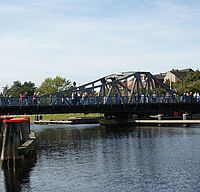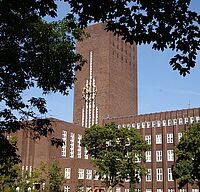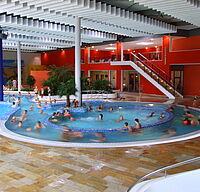 © Björn Lübbe
© Björn Lübbe BANTER RUINE / BANTER SEE
The ruins on the banks of the lake are a reminder of the old Banter Church which was destroyed along with the entire settlement of Bant during the horrendous „Antonius Flood“ in 1511. The church was reconstructed in 1889.

DEICHBRÜCKE
This bridge, crossing a shipping bottleneck which links the Ems-Jade Canal with the Greater Harbour, was built in 1908.

TRIPS AROUND THE HARBOUR
Boats start from the Helgolandkai (Helgoland Quay) for trips around the harbour, passing the Südstrand, or to the tanker terminal and the JadeWeserPort. You can also enjoy a rustical, humorous trip around the inland port on the harbour launch previously employed in Hamburg harbour. During the summer months, there is also a line to Butjadingen.
 © Stöver
© Stöver NASSAUBRÜCKE
The special feature of the „Nassau“ bridge, built over 90 years ago, is its ability to adapt to the respective water level. It is part of the Nassau harbour, named after the naval ship S.M.S. Nassau whose crew was the first to use the bridge.
 © Björn Lübbe
© Björn Lübbe SHOPPING
The Nordsee Passage, located directly adjacent to the railway station, combines shopping and gastronomy under one, high, glass roof. You can find fashion clothes, shoes, jewellery, gourmet foods, lowers, books and everything you need to enjoy a typical East Frisian tea in an area over 35,000 sq. metres. Behind the shopping centre is Marktstrasse, Wilhelmshaven‘s main shopping mall. Traditional shops and international businesses lie side-by-side.
 © Björn Lübbe
© Björn Lübbe ROBERT-KOCH-HAUS
Daily, at 8 a.m. 12 noon and 6 p.m., bells chime a folk song from the gable of one of the most beautiful buildings in the town. The house was built in 1906 and has accommodated the public health office since 2000. Therefore, it is named after Robert Koch, a renowned German doctor.
 © Björn Lübbe
© Björn Lübbe KAISER-WILHELM-MEMORIAL
There is a memorial to Kaiser Wilhelm I, the founder of the town, on Friedrich-Wilhelm-Platz. It is a replica, the original having been melted down during the 2nd World War. About 50 metres away is a tidal clock. You can read when low and high tides will occur.
 © Lübbe
© Lübbe CHRISTUS- UND GARNISONKIRCHE
One of the things to admire in this church of the cross, built between 1869 and 1872, is the altarpiece from Hugo Schnars-Alquist which depicts a rough sea with cross. Coats of arms from naval ships and plaques from the Kaiser‘s navy convey the last respects to mariners in the last century.
 © Björn Lübbe
© Björn Lübbe WERFTTOR/ MARINEARSENAL
The main entrance to the Arsenal, built of brick and originally developed in 1876 as the Kaiser‘s docks, has a majestic appearance. You can find the only Kaiser era letterbox, made of cast iron, remaining in Germany.
 © Björn Lübbe
© Björn Lübbe PRINZ-ADALBERT-MEMORIAL
Prince Adalbert of Prussia was the first admiral in the Prussian Navy and initiator for the founding of Wilhelmshaven. The memorial at Adalbertplatz was draughted by the sculpturer Karl Schuler from Berlin and was financed by donations from naval officers.
 © Björn Lübbe
© Björn Lübbe KURPARK
The entrance to the park, planned in 1870, leads through the beautiful, brick Hindenburg Gate. The park was given its name in the 1920s when Wilhelmshaven was popular as a spa and resort town. The „music mussel“ opposite the duck pond was build in the 1960s.

RATHAUS
The draught completed by the well-known architect Fritz Höger was actually realised in 1928/29. The townhall tower also serves as a water reservoir.
 © Björn Lübbe
© Björn Lübbe KOPPERHÖRNER MÜHLE
The mill has not been in use for over 80 years but the windmill, with its 22-metre long sails made in 1839, still functions. It stands under the protection of historic buildings and sites act and is open to visitors on the first Sunday of every month.

HEPPENSER KIRCHE ST. NIKOLAI
This medieval church built in the 15th century stands on a dwelling mound, has survived all floods and is well worth a visit if only for a look at the Münstermann pulpit and Roman baptismal font. The historical church windows have been supplemented by two modern windows created by the Wilhelmshaven artist Hartmut Wiesner.

SIBETSBURG
It is rumoured that Störtebeker once resided here as a guest. Apart from a commemorative stone on a hill and some built-up ground plans however, there is not much to see of the castle owned by his host Chief Edo Wiemken the Elder.

NAUTIMO UND FREIBAD NORD
The „Nautimo“ water park not only provides two tunnel slides and diving boards but also a lazy river, bubbling underwater massage, outdoor pools, paddling pool, a 25-meter pool for competitive swimmers and a large sauna landscape. The open-air pool area at "Freibad Nord" is equipped with a 50-metre pool, baby pool, volleyball pitch and lawn for sunbathing to enjoy warm, sunny days.
 © Lübbe
© Lübbe ROSARIUM, BOTANICAL GARDEN AND STADT- PARK WITH WAR CEMETARY
After taking a walk through the park, it is worth stopping of at the Bootshaus Café with its terrace directly beside the duck pond. Paddle boats and rowing boats are available for hire. The War Cemetery is located at the north border of the park where 3,000 fallen soldiers from the two world wars rest in peace. The Rosarium, the only one of its kind in Northwest Germany offers an unforgettable experience to flower-lovers.

STÖRTEBEKER PARK
Scaled-down forts, rafting trips, a sun dial and a pancake café ensure that children‘s hearts beat even faster. The park is open between April and October from Mondays to Fridays and Sundays. Entrance is free.